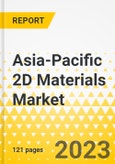This report comes with 10% free customization, enabling you to add data that meets your specific business needs.
Market Introduction
The 2D materials industry in Asia-Pacific (APAC) is expanding. The region's fuel cell vehicle market is expected to grow as a result of rising fuel cell adoption rates as well as increased focus on pollution prevention and decarbonization. Furthermore, the strong demands from end-user industries and the expanding requirement for transparent conductive films (TCF) in the electronics industry would likely lead to increased demand in the APAC market. The market for 2D materials is anticipated to continue growing as a result of the growing nanomaterials market in Asia-Pacific. Interestingly, applications in sports equipment and photovoltaics in the area are driving demand for 2D materials.Market Segmentation:
Segmentation 1: by End User
- Composite and Coatings
- Energy Storage Devices
- Electronics
- Semiconductor
- Pharmaceuticals
- Automobiles
- Others
Segmentation 2: by Material Type
- Graphene
- Black Phosphorous
- Transition Metal Dichalcogenides
- Mxene
- Hexagonal boron nitride
- Others
Segmentation 3: by Country
- Japan
- India
- South Korea
- Australia
- Rest-of-Asia-Pacific and Japan
How can this report add value to an organization?
Product/Innovation Strategy: The product segment helps the reader to understand the different material types involved in 2D materials. Moreover, the study provides the reader with a detailed understanding of the Asia-Pacific 2D materials market based on the end user (composite and coatings, energy storage devices, electronics, semiconductors, pharmaceuticals, automobiles, and others). 2D materials are gaining traction in end-user industries on the back of sustainability concerns and their high durability properties. They are also being used for controlling greenhouse gas (GHG) emissions.Growth/Marketing Strategy: The Asia-Pacific 2D materials market has seen major development by key players operating in the market, such as business expansions, partnerships, collaborations, mergers and acquisitions, and joint ventures. The favored strategy for the companies has been product developments, business expansions, and acquisitions to strengthen their position in the Asia-Pacific 2D materials market.
Competitive Strategy: Key players in the Asia-Pacific 2D materials market analyzed and profiled in the study involve 2D materials manufacturers and the overall ecosystem. Moreover, a detailed competitive benchmarking of the players operating in the Asia-Pacific 2D materials market has been done to help the reader understand how players stack against each other, presenting a clear market landscape. Additionally, comprehensive competitive strategies such as partnerships, agreements, acquisitions, and collaborations will aid the reader in understanding the untapped revenue pockets in the market.
Key Market Players and Competition Synopsis
The companies that are profiled have been selected based on inputs gathered from primary experts, analyzing company coverage, product portfolio, and market penetration.Some of the prominent established names in this market are:
- 6Carbon Technology
- Nitronix Nanotechnology Corporation
- 2D Water
This product will be delivered within 3-5 business days.
Table of Contents
Executive Summary
The Asia-Pacific 2D materials market (excluding China) is estimated to reach $756.0 million by 2031, reveals the premium market intelligence study. The study also highlights that the market is set to witness a CAGR of 25.9% during the forecast period 2022-2031.Consumer electronics, automotive, wearable electronics, aerospace, and defense, among other industries, are the 2D materials market's end-user segments in the Asia-Pacific and Japan region. Additionally, Asia-Pacific has the highest demand for mobility, elevating the region to the status of an automotive hub among consumers.
USPs of report
Market ranking analysis based on product portfolios and recent developments
- Analysis of business drivers and challenges of the Asia-Pacific 2D Materials Market
- Detailed analysis of 2D Materials Market for Japan, India, South Korea and Australia
- A detailed company profile comprising established players
Market segregation based on material type and end-user
Analyst’s Perspective on Asia-Pacific 2D Materials Market
The Principal Analyst states, '2D materials have gained growth in recent years due to a growing emphasis on environmentally friendly and emerging 2D materials. Due to their outstanding strength, compact size, flexibility, and superior thermal and electrical conductivity, 2D materials are distinctive in many ways. Furthermore, due to several technical and performance advancements in various 2D materials such as Mxene, hexagonal boron nitride, and TMDCs, among others, the market is anticipated to expand quickly during the forecast period.'Some of the prominent names established in this market are:
- 6Carbon Technology
- Nitronix Nanotechnology Corporation
- 2D Water
Key Questions Answered in the Report
- What are the main bottlenecks for scaling up 2D materials, and how can they be overcome?
- Where do you see the greatest need for additional R&D efforts?
- What are the advantages of the emerging 2D materials that are entering the market, and how are they used in various applications?
- Which applications (by end user) and products (by material type) segments are leading in terms of consumption of the 2D materials market, and which of them are expected to witness high demand growth during 2022-2031?
Companies Mentioned
- 6Carbon Technology
- Nitronix Nanotechnology Corporation
- 2D Water
Table Information
| Report Attribute | Details |
|---|---|
| No. of Pages | 121 |
| Published | November 2023 |
| Forecast Period | 2022 - 2031 |
| Estimated Market Value ( USD | $ 95.2 Million |
| Forecasted Market Value ( USD | $ 756 Million |
| Compound Annual Growth Rate | 25.9% |
| Regions Covered | Asia Pacific |
| No. of Companies Mentioned | 3 |









